Illinois's first congressional district is a congressional district in the U.S. state of Illinois. Based in Cook County, the district includes much of the South Side of Chicago and continues southwest to Joliet.
| Illinois's 1st congressional district | |||
|---|---|---|---|
Interactive map of district boundaries since January 3, 2023 | |||
| Representative |
| ||
| Area | 621.6 sq mi (1,610 km2) | ||
| Population (2022) | 728,550 | ||
| Median household income | $64,107[1] | ||
| Ethnicity |
| ||
| Cook PVI | D+20[2] | ||
From 2003 to early 2013 it extended into the city's southwest suburbs until reaching the border of Will County, and covered 97.84 square miles (253.4 km2), making it one of the 40 smallest districts in the U.S. (although there are four smaller districts in Illinois). The district had a population that was 65% African American, the highest percentage of any congressional district in the nation, but with redistricting that percentage has now declined to 52%. It includes the home of former President Barack Obama.
The 1st is a majority-minority district, and has been since at least the 1920s. In 1929, it became the first district in the 20th century to send an African American to Congress when Republican Oscar Stanton De Priest was elected to represent the district. The 1st has been represented by an African American Member of Congress ever since, the longest ongoing stretch of black representation for any seat in the House of Representatives. It has been held by a Democrat since 1935 when Arthur Mitchell, the first African American Democrat elected to Congress, took the seat as part of the New Deal Coalition. In 1949, district representative William Dawson became the first African American to chair a congressional committee.
The district is currently represented by Jonathan Jackson who was elected to succeed longtime incumbent Bobby Rush in 2022.[3]
Historical boundaries edit
The district was adjacent to the 2nd district to the east and south, the 7th district to the north, and the 3rd and 13th districts to the west, and also bordered the 11th district at its southwest corner. The district's northeast border followed Lake Michigan's shoreline for almost a mile.
The district was created following the 1830 U.S. census and came into existence in 1833, five months before Chicago was organized as a town; the state was previously represented in the U.S. House of Representatives with representative elected on an at-large basis. The district included Southwestern Illinois until 1853.[4][5] It included the state's northern edge until 1863.[6] Since that time, the district has included all or part of Cook County; since 1883 the population of the district has been primarily residing on Chicago's South Side. Historical populations reflected waves of immigration into the area: previous majority populations were ethnic Irish, German, and east European. Beginning in the mid-19th century, the Irish were the first to establish their physical and political control of the area within the city's South Side.
The current 1st district has a minority-majority population: 51.3% of the residents are African-American.[7] It has been represented in Congress by African Americans since 1929. Tens of thousands of African Americans moved to Chicago from the rural South in the Great Migration. They were confined by discrimination to the South Side of Chicago and gradually replaced ethnic whites who moved out to suburbs. At one point during the 1980s, more than 90% of the district's residents were black.[8]
While successive redistrictings have given the district a larger percentage of white voters, it is still one of the most reliably Democratic districts in the country; with a Cook Partisan Voting Index of D+28, it is the fourth most Democratic district of the eight that divide Chicago. The district has not sent a Republican to the U.S. House of Representatives since 1935. After the civil rights movement gained support from national Democratic Party for major legislation to restore constitutional rights, including the franchise in the South, most African Americans shifted to support the Democratic Party. Democratic congressional candidates routinely receive over 80% of the vote here. The Democratic trend runs right through to the national level; since the 1950s, Democratic presidential candidates have usually carry the district with well over 70 percent of the vote, and have done no worse than 64 percent/
Geography edit
Based in Chicago, the district includes the neighborhoods of Auburn Gresham, Burnside, Chatham and Greater Grand Crossing; almost all of West Englewood; the portion of Englewood south of 57th Street; the portion of Woodlawn west of Stony Island Avenue (i.e. excluding Jackson Park); the southern half of Kenwood (home of President Barack Obama); the eastern portion of Ashburn; parts of Avalon Park, Calumet Heights, Chicago Lawn, Douglas, Grand Boulevard, Hyde Park, Morgan Park, New City, Oakland, Roseland, South Shore, Washington Heights and Washington Park; the portion of Beverly southeast of 97th Street and Prospect Avenue; the portion of West Pullman southwest of 119th Street and Racine Avenue; and approximately two square blocks at the northwest corner of South Chicago.
The district's area south of 95th Street is almost entirely west of Interstate 57. The district includes the municipalities of Crestwood, Evergreen Park, Midlothian, Posen and Robbins, nearly all of Alsip, Blue Island and Oak Forest, parts of Calumet Park, Dixmoor, Markham, Orland Hills, Orland Park, Palos Heights, Tinley Park and Worth, and some small sections of Country Club Hills and Riverdale.
Demographics edit
In the twentieth century after the Great Migration from the South and concentration of blacks on the South Side due to de facto residential segregation, the district became the nation's first with a black-majority population. Since the 1920s, it has included the central area of Chicago's South Side African-American community. Over 85% of the district's residents were black during the period from the 1950s through the 1980s, but redistricting since that time – which redrew the district lines with the goal of maintaining three Chicago districts with black populations exceeding 60% – has reduced the percentage of black residents in the district to 70% in the 1990s. The current figure is 65%. Outward migration has caused the South Side's population to decrease over the years, and the district was expanded geographically to the southwest to gain residents, particularly as the state's congressional delegation has been reduced in numbers due to population changes and reapportionment. The district, which covered only nine square miles in the 1950s, is now more than ten times that size. Nearly half its current area was added for the 2000s.
The district's population dropped by 27% in the 1950s,[9] and by 20% in both the 1970s and 1980s, due to outward migration for suburbanization and because of people leaving the area due to loss of jobs.[8][10] In redistricting after the 1990 U.S. census, the district was extended into the suburbs for the first time in 90 years. Chicago is home to 70% of the district's residents (down from 90% in the 1990s),[11] although roughly 60% of the district's area is outside the city border. The district's white population (almost 30% of its residents) is concentrated in the suburban areas and in a few Chicago neighborhoods such as Hyde Park.[12] The district's largest white ethnic groups are Irish (7.1%), German (6.2%), Polish (4.5%) and Italian (3.2%),[13] mirroring the demographics of the neighboring third and thirteenth congressional districts. There are also sizable Dutch, Swedish, Czech, Palestinian, Greek and Lithuanian populations in the area of Oak Forest, Orland Park and Tinley Park, the district's three largest suburbs.
The Kenwood-Hyde Park area for several decades had a significant Jewish community. Existing buildings attest to its history, as the former Kehilath Anshe Ma'ariv temple (its second location) has been the headquarters of Jesse Jackson's Operation PUSH/Rainbow Coalition since 1971 [1]. The area also includes a notable presence of Black Muslims and is the home of Nation of Islam leader Louis Farrakhan in Kenwood.
As of 2000, 38% of the district's adult residents were married.
Redistricting edit
2011 cycle edit
In 2011, following the 2010 census, the state legislature redistricted. It expanded the district to cover parts of Cook and Will Counties. After redistricting, all or parts of Alsip, Blue Island, Calumet Park, Chicago, Country Club Hills, Crestwood, Dixmoor, Elwood, Evergreen Park, Frankfort, Frankfort Square, Harvey, Manhattan, Markham, Merrionette Park, Midlothian, Mokena, New Lenox, Oak Forest, Oak Lawn, Orland Hills, Orland Park, Palos Heights, Posen, Riverdale, Robbins, Tinley Park, and Worth are included.[14] The representative for these districts were elected in the 2012 primary and general elections, and the boundaries became effective on January 3, 2013.
2021 cycle edit
| # | County | Seat | Population |
|---|---|---|---|
| 31 | Cook | Chicago | 5,173,146 |
| 91 | Kankakee | Kankakee | 106,601 |
| 197 | Will | Joliet | 697,252 |
As of the 2020 redistricting, the district will still be centered primarily around the Chicago's South Side, now with a greater portion of Will County, and a corner of northern Kankakee County.
The 1st district takes in the Chicago neighborhoods of Oakland, Burnham Park, Auburn Gresham, Washington Heights, Greater Grand Crossing, Chatham, and Burnside; most of Ashburn, Roseland, and Calumet Heights; the west portion of Kenwood and Woodlawn; and parts of South Deering, Near South Side, Douglas, Chicago Lawn, South Shore, South Chicago, Hyde Park, Washington Park, Morgan Park, and Mt. Greenwood.
Outside of the Chicago city limits, the district takes in the Cook County communities of Midlothian, Posen, and Robbins; most of Blue Island; the south portion of Lemont; and parts of Oak Forest, Orland Park, Crestwood, and Beverly.
Will County is split between this district, the 2nd district, and the 14th district. The 1st and 2nd districts are partitioned by South Harlem Ave, West Peotone Rd, North Peotone Rd, West Kennedy Rd, Rock Creek, and South Center Rd. The 1st and 14th districts are partitioned by West 135th St, High Rd, Chicago Sanitary & Ship Canal, Thornton St, East 9th St, Madison St, East 12th St, East Division St, South Farrell Rd, Midewin National Tail Grass Prairie, West Schweizer Rd, Channahon Rd, DuPage River, and Canal Road North. The 1st district takes in the municipalities of Homer Glen, Braidwood, Minooka, Wilmington, Manhattan, Frankfort, Channahon, and New Lenox; Lockport east of the Chicago Sanitary & Ship Canal; and part of Joliet.
Kankakee County is split between this district and the 2nd district. They are partitioned by North 5000E Rd, East 6000N Rd, Cardinal Drive, Durham St, East Armour Rd, East Marsile St, Bisallion Ave, and the Kankakee River. The 1st district takes in the municipalities of Manteno; half of Bourbannais; and part of Bradley.
Presidential election results edit
- This table indicates how the district has voted in U.S. presidential elections; election results reflect voting in the district as it was configured at the time of the election, not as it is configured today. The candidate who received the most votes in the district is listed first; the candidate who won the election nationally is in CAPS, and the candidate who won the state of Illinois is indicated with a †.
| Election | District winner | Runner up | Other candidates |
|---|---|---|---|
| 1852[15] | Scott (W), 6,992 (42%) | PIERCE† (D), 6,948 (41%) | Hale (Free Soil), 2,885 (17%) |
| 1856[15] | Frémont (R), 18,247 (73%) | BUCHANAN† (D), 5,991 (24%) | Fillmore (American), 677 (3%) |
| 1860[15] | LINCOLN† (R), 21,436 (70%) | Douglas (D), 8,940 (29%) | Bell (Constitutional Union), 99 (0.3%); Breckinridge (D), 62 (0.2%) |
| 1864[15] | LINCOLN† (R), 18,667 (81%) | McClellan (D), 4,351 (19%) | |
| 1868[15] | GRANT† (R), 27,527 (59%) | Seymour (D), 19,104 (41%) | |
| 1872 ... 1948 | [data missing] | ||
| 1952[16] | Stevenson (D), 99,224 (75%) | EISENHOWER† (R), 33,805 (25%) | |
| 1956[16] | Stevenson (D), 68,266 (64%) | EISENHOWER† (R), 38,827 (36%) | |
| 1960[17] | KENNEDY† (D), 75,938 (77.80%) | Nixon (R), 21,660 (22.19%)} | |
| 1964[18] | JOHNSON† (D), 150,953 (84.91%) | Goldwater (R), 26,823 (15.08%) | |
| 1968[19] | Humphrey (D), 138,835 (93%) | NIXON† (R), 10,081 (7%) | Wallace (AIP), 1,010 (1%) |
| 1972[20] | McGovern (D), 145,003 (90%) | NIXON† (R), 16,998 (10%) | |
| 1976[21] | CARTER (D), 130,882 (90%) | Ford† (R), 13,817 (10%) | |
| 1980[22] | Carter (D), 128,426 (91%) | REAGAN† (R), 6,633 (5%) | Anderson (Indep.), 3,092 (2%) |
| 1984[23] | Mondale (D), 196,351 (95%) | REAGAN† (R), 10,153 (5%) | |
| 1988[24] | Dukakis (D), 174,793 (95%) | G. H. W. BUSH† (R), 7,168 (4%) | |
| 1992[25] | CLINTON† (D), 214,104 (81%) | G. H. W. Bush (R), 32,803 (12%) | Perot (Indep.), 17,355 (7%) |
| 1996[26] | CLINTON† (D), 179,767 (85%) | Dole (R), 22,914 (11%) | Perot (Reform), 6,378 (3%) |
| 2000[27] | Gore† (D), 194,432 (87%) | G. W. BUSH (R), 24,276 (11%) | Nader (Green), 2,867 (1%) |
| 2004[28] | Kerry† (D), 234,086 (83%) | G. W. BUSH (R), 47,533 (17%) | |
| 2008[7] | OBAMA† (D) 287,240 (81%) | McCain (R) 66,840 (19%) | |
| 2012[7] | OBAMA† (D) 262,836 (79%) | Romney (R) 67,557 (20%) | |
| 2016[7] | Clinton† (D) 262,836 (79%) | TRUMP (R) 67,557 (20%) | |
| 2020[7] | BIDEN† (D) 246,946 (74%) | Trump (R) 82,594 (25%) | |
Results from recent statewide elections edit
- This table indicates how the district has voted in recent statewide elections; election results reflect voting in the district as it is currently configured, not necessarily as it was at the time of these elections.
| Year | Office | Results |
|---|---|---|
| 2016 | President | Hillary Clinton 71.9% – Donald Trump 24.0% |
| Senate | Tammy Duckworth 71.9% – Mark Kirk 23.5% | |
| 2018 | Governor | J. B. Pritzker 71.2% – Bruce Rauner 24.4% |
| Attorney General | Kwame Raoul 71.1% – Erika Harold 26.9% | |
| Secretary of State | Jesse White 80.1% – Jason Helland 18.0% | |
| 2020 | President | Joe Biden 70.5% – Donald Trump 28.1% |
| Senate | Dick Durbin 61.1% – Mark Curran 25.2% | |
| 2022 | Senate | Tammy Duckworth 69.5% – Kathy Salvi 29.2% |
| Governor | J. B. Pritzker 67.7% – Darren Bailey 30.0% | |
| Attorney General | Kwame Raoul 68.2% – Tom DeVore 30.1% | |
| Secretary of State | Alexi Giannoulias 68.2% – Dan Brady 29.9% |
Economy edit
The departure of the steel industry, along with other manufacturing jobs from the South Side in recent decades, has created economic difficulties which the area is still trying to overcome. The district's median household income as of 2000, $37,222, trailed the national average by 11.4%. The unemployment rate (7.6%) was more than double the national rate, and nearly 20% of district residents were living in poverty. These problems are more pronounced within the Chicago portion of the district – 14 of the district's 18 suburbs had median household incomes over $40,000 as of 1999, with the six most affluent grouped in the southwest corner of the district. But black middle-class Chicago neighborhoods, such as Avalon Park and Chatham, have remained more stable, along with the more upscale Hyde Park-Kenwood area. Health care and higher education now constitute major economic sectors in the region.
Hospitals in the district include Oak Forest Hospital in Oak Forest and Provident Hospital of Cook County in Grand Boulevard, both part of the Cook County Bureau of Health Services; as well as the University of Chicago Hospitals in Hyde Park, Little Company of Mary Hospital in Evergreen Park, Holy Cross Hospital in Chicago Lawn, St. Francis Hospital in Blue Island, Jackson Park Hospital in South Shore and St. Bernard Hospital in Englewood.
Local educational institutions include the University of Chicago in Hyde Park, Illinois Institute of Technology (IIT) in Douglas, Trinity Christian College in Palos Heights and Kennedy-King College, a Chicago city college, in Englewood, and Chicago State University in Roseland is located directly outside the district at its southern edge; in addition, there are five seminaries in Hyde Park: Catholic Theological Union, Chicago Theological Seminary, Lutheran School of Theology, McCormick Theological Seminary and Meadville Lombard Theological School.
U.S. Cellular Field, home of the Chicago White Sox, is less than 1,000 feet (300 m) west of the district's northwestern border. Other area cultural and entertainment attractions include the DuSable Museum of African American History in Chicago's Washington Park, and First Midwest Bank Amphitheatre in Tinley Park; several square miles of Cook County Forest Preserves can be found on three sides of Oak Forest, and Oak Forest's Chicago Gaelic Park [2] is home to Irish Fest, held annually on Memorial Day weekend. Business and industrial presences in the district include Panduit Corporation [3], an electrical manufacturer in Tinley Park; Parco Foods [4], a cookie manufacturer in Blue Island; and Midwest Suburban Publishing, publisher of the SouthtownStar, in Tinley Park.
In addition to Washington Park and those sites associated with the University of Chicago and IIT, district locations on the National Register of Historic Places include:
Politics edit
Democrats routinely dominate politics in the district, with the main focus of competition being the party primary. Only twice since 1966 has a Republican candidate for Congress received over 20% of the vote,[29] and the Democratic nominee has topped 80% in every presidential race during that time. The district's expansion into the suburbs in the 1990s has incorporated a population that has voted Republican more often; Republican support has passed the 10% mark, and George W. Bush received 17% of the vote here in 2004. His was the best showing by a Republican presidential candidate in the district in over 40 years.
The district has since the early 1970s elected representatives who dissented from the city's Democratic establishment. William L. Dawson, U.S. Representative from 1943 to 1970, maintained the district's loyalty to Mayor Richard J. Daley. His successor Ralph Metcalfe initially continued that stance but publicly broke with Daley over an incident of police brutality in 1972, establishing a rift that persists. When Metcalfe died less than one month before the election in 1978, Democratic party officials named loyalist Bennett M. Stewart to take his place on the ballot, and Republicans replaced their candidate with A.A. "Sammy" Rayner, a former Democratic alderman. Despite the campaign support of Jackson for Rayner, Stewart won the election, although Rayner did get over 40% of the vote.[30][31]
Stewart served only one term and lost the 1980 Democratic primary to reform candidate Harold Washington. He left Congress in 1983 upon being elected mayor, after winning a contentious three-way primary with 37% of the vote. His successor in Congress was union organizer Charles Hayes. Hayes lost the 1992 primary to Bobby Rush by a 42–39% margin following the House banking scandal, in which it was revealed that Hayes had 716 overdrafts on his congressional checking account.[32] Rush had previously lost the 1988 and 1990 primaries to Hayes.

Rush was a co-founder of the Illinois Black Panthers in 1968, establishing a program for free breakfasts for poor children and a clinic for sickle cell anemia screenings.[33] He served as a Chicago alderman from 1983 until his election to Congress in 1993, and he was an ally of Mayor Washington in the Council Wars of the 1980s. While in Congress, Rush consistently voted with the Democratic position over 90% of the time. When he did break from the party, he usually took positions more liberal than other Democrats, rather than taking positions held by Republicans.[34] Rush ran against incumbent Richard M. Daley in the 1999 election for Mayor of Chicago. Despite the support of fellow congressmen Jesse Jackson Jr. and Danny Davis, he was backed by only three out of 50 aldermen and lost the election by a margin of 72–28%. He had a 55–45% advantage among black voters. In the 2000 congressional primary Rush emerged with a 61–30% win over challenger Barack Obama resulting in Obama's only electoral defeat.[35]
In Congress, Rush focused on urban revitalization issues, and he was a staunch supporter of gun control efforts before his adult son Huey (named for Black Panther leader Huey Newton) was killed in a 1999 mugging. Following his son's murder, Rush remained a strong supporter of gun control.[33] During his congressional tenure, Rush generally received perfect ratings of 100 from labor groups including the AFL-CIO and AFSCME, and occasionally also from Americans for Democratic Action, the ACLU and the National Abortion Rights Action League. His lifetime rating from the American Conservative Union is 3.93 on a 0 to 100 scale.[28][36][37][38]
Prominent representatives edit
| Representative | Notes |
|---|---|
 John Reynolds | Associate Justice of the Illinois Supreme Court (1818–1824) Elected the 4th governor of Illinois (1830–1834) |
 William Henry Bissell | Elected the 11th governor of Illinois (1857–1860) |
 John Wentworth | Elected the 21st mayor of Chicago (1860–1861) |
 Elihu B. Washburne | Served as Dean of the U.S. House of Representatives (1863–1869) Appointed the 25th U.S. Secretary of State (1869) Appointed the U.S. minister to France (1869–1877) |
 John Blake Rice | Elected the 24th mayor of Chicago (1865–1869) |
 Norman B. Judd | Appointed the U.S. envoy to Prussia (1867–1871) |
 Charles B. Farwell | Elected U.S. Senator from Illinois (1887–1891) |
 James Robert Mann | Served as U.S. House Minority Leader (1911–1919) |
 William L. Dawson | Served as a first lieutenant in the U.S. Army during World War I (1917–1919) First African-American to chair a congressional committee. |
 Ralph Metcalfe | Olympian (1932, 1936) Served as a first lieutenant in the U.S. Army during World War II (1942–1945) |
 Harold Washington | Elected the 51st mayor of Chicago (1983–1987) First African-American mayor of Chicago |
List of members representing the district edit
| Member | Party | Years | Cong ress | Electoral history | District location |
|---|---|---|---|---|---|
| District created March 4, 1833 | |||||
| Charles Slade (Carlyle) | Jacksonian | March 4, 1833 – July 26, 1834 | 23rd | Elected in 1832. Died. | 1833–1843 Included the sixteen counties in the state's southwestern section: Alexander, Bond, Clinton, Franklin, Gallatin, Jackson, Johnson, Macoupin, Madison, Monroe, Perry, Pope, Randolph, St. Clair, Union and Washington counties (five additional counties were later created within this area).[4] |
| Vacant | July 26, 1834 – December 1, 1834 | 23rd | |||
 John Reynolds (Belleville) | Jacksonian | December 1, 1834 – March 3, 1837 | 23rd 24th | Elected to finish Slade's term Re-elected in 1834. Lost re-election. | |
 Adam W. Snyder (Belleville) | Democratic | March 4, 1837 – March 3, 1839 | 25th | Elected in 1836. Retired. | |
 John Reynolds (Belleville) | Democratic | March 4, 1839 – March 3, 1843 | 26th 27th | Elected in 1838. Re-elected in 1840. [data missing] | |
 Robert Smith (Alton) | Democratic | March 4, 1843 – March 3, 1847 | 28th 29th | Elected in 1842. Re-elected in 1844. Re-elected in 1846. [data missing] | 1843–1853 Reduced in size, and now included eleven counties: Alexander, Bond, Clinton, Jackson, Madison, Monroe, Perry, Randolph, St. Clair, Union and Washington counties.[5] |
| Independent Democratic | March 4, 1847 – March 3, 1849 | 30th | |||
 William H. Bissell (Belleville) | Democratic | March 4, 1849 – March 3, 1853 | 31st 32nd | Elected in 1848. Re-elected in 1850. [data missing] | |
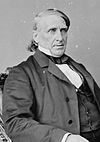 Elihu B. Washburne (Galena) | Whig | March 4, 1853 – March 3, 1855 | 33rd | Elected in 1852. Re-elected in 1854. Re-elected in 1856. Re-elected in 1858. Re-elected in 1860. [data missing] | 1853–1863 Shifted north to cover the eight counties along the state's northern edge: Boone, Carroll, Jo Daviess, Lake, McHenry, Ogle, Stephenson and Winnebago counties.[6] Ulysses S. Grant was a district resident in 1860–61 during the period when he was out of the Army, working in his family's store in Galena, and he became acquainted with Congressman Elihu B. Washburne; Washburne became his political mentor and sponsor, and eventually became Grant's first Secretary of State. |
| Republican | March 4, 1855 – March 3, 1863 | 34th 35th 36th 37th | |||
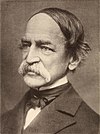 Isaac N. Arnold (Chicago) | Republican | March 4, 1863 – March 3, 1865 | 38th | Elected in 1862. [data missing] | 1863–1873 During this decade, beginning during the Civil War, consisted of all of Cook County.[39] Industrialist Cyrus McCormick lost the 1864 House election as the Democratic candidate.[40] Later during this period, the district was devastated by the Great Chicago Fire in October 1871. |
 John Wentworth (Chicago) | Republican | March 4, 1865 – March 3, 1867 | 39th | Elected in 1864. [data missing] | |
 Norman B. Judd (Chicago) | Republican | March 4, 1867 – March 3, 1871 | 40th 41st | Elected in 1866. Re-elected in 1868. Retired. | |
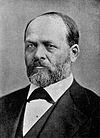 Charles B. Farwell (Chicago) | Republican | March 4, 1871 – March 3, 1873 | 42nd | Elected in 1870. [data missing] | |
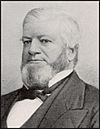 John B. Rice (Chicago) | Republican | March 4, 1873 – December 17, 1874 | 43rd | Elected in 1872. Retired and then died. | 1873–1883 Restructured and now included DuPage County, the thirteen townships comprising the southern half of Cook County (Bloom, Bremen, Calumet, Hyde Park, Lake, Lemont, Lyons, Orland, Palos, Rich, Riverside, Thornton, Worth), and the entire South Side and part of the West side of Chicago. The Chicago portion of the district began downtown and extended south to 39th Street (now Pershing Road) east of the Chicago River and south of the river and the Illinois and Michigan Canal, with its western boundary being Western Avenue; on the west side, the district included the area between 16th Street on the north and the river and canal on the south, with the city's western boundary then being Crawford Avenue (now Pulaski Road).[41] |
| Vacant | December 17, 1874 – February 1, 1875 | ||||
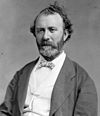 Bernard G. Caulfield (Chicago) | Democratic | February 1, 1875 – March 3, 1877 | 43rd 44th | Elected to finish Rice's term. Re-elected in 1874. Retired. | |
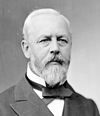 William Aldrich (Chicago) | Republican | March 4, 1877 – March 3, 1883 | 45th 46th 47th | Elected in 1876. Re-elected in 1878. Re-elected in 1880. Lost renomination. | |
 Ransom W. Dunham (Chicago) | Republican | March 4, 1883 – March 3, 1889 | 48th 49th 50th | Elected in 1882. Re-elected in 1884. Re-elected in 1886. Retired. | 1883–1895 Remained identical to its previous configuration, except that it no longer included DuPage County or the portion of Chicago west of Clark Street between 16th and 39th Streets.[42] Illinois gained two additional representatives following the 1890 census, but they were elected on an at-large basis for the 1893–1895 term before redistricting occurred, and the previous decade's districting remained in effect.[43] |
 Abner Taylor (Chicago) | Republican | March 4, 1889 – March 3, 1893 | 51st 52nd | Elected in 1888. Re-elected in 1890. Retired. | |
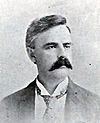 J. Frank Aldric (Chicago) | Republican | March 4, 1893 – March 3, 1897 | 53rd 54th | Elected in 1892. Re-elected in 1894. Retired. | |
| 1895–1903 Included the seven townships in southeastern Cook County (Bloom, Bremen, Calumet, Orland, Rich, Thornton, Worth), and the portion of Chicago's South Side bordered on the north by 26th Street, and on the west by Wentworth Avenue from 26th to 39th Streets and by State Street from 39th to 63rd Streets before following 63rd Street west to the city's border with Lyons Township (then at Cicero Avenue).[44] | |||||
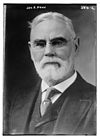 James Robert Mann (Chicago) | Republican | March 4, 1897 – March 3, 1903 | 55th 56th 57th | Elected in 1896. Re-elected in 1898. Re-elected in 1900. Redistricted to the 2nd district. | |
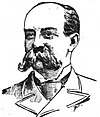 Martin Emerich (Chicago) | Democratic | March 4, 1903 – March 3, 1905 | 58th | Elected in 1902. Retired. | 1903–1949 Confined to the city of Chicago for the first time, and included downtown and the area east of Wentworth to 43rd Street, also reaching west to include Armour Square as well as most of Bridgeport northeast of 33rd and Halsted Streets.[45] Illinois's districts were not redrawn until 1947, taking effect for the 1948 elections.[46] In 1928, Oscar De Priest became the first African American elected to Congress in the 20th century. |
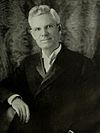 Martin B. Madden (Chicago) | Republican | March 4, 1905 – April 27, 1928 | 59th 60th 61st 62nd 63rd 64th 65th 66th 67th 68th 69th 70th | Elected in 1902. Re-elected in 1904. Re-elected in 1906. Re-elected in 1908. Re-elected in 1910. Re-elected in 1912. Re-elected in 1914. Re-elected in 1916. Re-elected in 1918. Re-elected in 1920. Re-elected in 1922. Re-elected in 1924. Re-elected in 1926. Died. | |
| Vacant | April 27, 1928 – March 3, 1929 | 70th | |||
 Oscar S. De Priest (Chicago) | Republican | March 4, 1929 – January 3, 1935 | 71st 72nd 73rd | Elected in 1928. Re-elected in 1930. Re-elected in 1932. Lost re-election. | |
 Arthur W. Mitchell (Chicago) | Democratic | January 3, 1935 – January 3, 1943 | 74th 75th 76th 77th | Elected in 1934. Re-elected in 1936. Re-elected in 1938. Re-elected in 1940. Retired. | |
 William L. Dawson (Chicago) | Democratic | January 3, 1943 – November 9, 1970 | 78th 79th 80th 81st 82nd 83rd 84th 85th 86th 87th 88th 89th 90th 91st | Elected in 1942. Re-elected in 1944. Re-elected in 1946. Re-elected in 1948. Re-elected in 1950. Re-elected in 1952. Re-elected in 1954. Re-elected in 1956. Re-elected in 1958. Re-elected in 1960. Re-elected in 1962. Re-elected in 1964. Re-elected in 1966. Re-elected in 1968. Re-elected in 1970. Died. | |
| 1949–1963 Included that part of Chicago bounded on the north by the river; on the east by the lake to Pershing Road and by Cottage Grove Avenue from Pershing to 71st Street and South Chicago Avenue; on the south by Marquette Road from State Street to South Chicago Avenue, following that southeast to 71st and Cottage Grove; and on the west by Wallace Street (from the river to 25th Street), Canal Street (25th to 31st Street), Wentworth (31st to 43rd Street), the railroad between State and Wentworth (43rd to 59th Street) and State Street (59th to Marquette).[47] The same boundaries were maintained in the redistricting after 1950.[48] | |||||
| 1963–1967 Included that part of Chicago between 31st and 99th Streets bounded on the west by Wentworth (31st to Garfield Boulevard), the railroad 1/4-mile east of Halsted (Garfield to 59th), Halsted (59th to 63rd), State Street (63rd to 83rd) and Stewart Avenue (83rd to 99th), and bounded on the east by the lake (31st to 46th), Cottage Grove (46th to 65th) and Stony Island Avenue (65th to 99th).[49] | |||||
| 1967–1973 Additional redistricting for the 1967–1969 term. All of the district's previous territory was retained, but it was extended further north as far as Cermak Road, with its western boundary being the railroad between State and Wentworth (Cermak to 28th Street) and then Wentworth (28th to Garfield). In addition, a small area east of Woodlawn Avenue between 46th and 47th Streets was added.[50] | |||||
| Vacant | November 9, 1970 – January 3, 1971 | 91st | |||
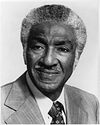 Ralph Metcalfe (Chicago) | Democratic | January 3, 1971 – October 10, 1978 | 92nd 93rd 94th 95th | Elected to finish Dawson's term. Re-elected in 1972. Re-elected in 1974. Re-elected in 1976. Died. | |
| 1973–1983 Included that part of Chicago between 31st and 103rd Streets bounded on the west by King Drive (31st to 35th), State (35th to Pershing), the railroad 1/4-mile west of State (Pershing to Garfield), King Drive (Garfield to Marquette), Yale Avenue (Marquette to 69th), Harvard Avenue (69th to 70th), Stewart (70th to 71st), Halsted (71st to 95th), the railroad 1/2-mile east of Halsted (95th to 99th) and State (99th to 103rd), and on the east by the lake (31st to 71st Street/South Shore Drive), Yates Boulevard (71st to 73rd), Jeffery Boulevard (73rd to 75th) and Stony Island, continuing onto the Calumet Expressway (75th to 103rd, with minor variation at 95th).[51] | |||||
| Vacant | October 10, 1978 – January 3, 1979 | 95th | |||
 Bennett M. Stewart (Chicago) | Democratic | January 3, 1979 – January 3, 1981 | 96th | Elected in 1978. Lost renomination. | |
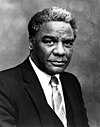 Harold Washington (Chicago) | Democratic | January 3, 1981 – April 30, 1983 | 97th 98th | Elected in 1980. Re-elected in 1982. Resigned to become Mayor of Chicago. | |
| 1983–1993 The only remaining district entirely within the city of Chicago, and included that area between Cermak Road and 103rd Street bounded on the west by Federal Street (Cermak to 25th), the railroad 1/4-mile west of State (25th to 35th), the railroad 1/2-mile east of Halsted (35th to 42nd and 43rd to 47th), Stewart (42nd to 43rd), Morgan Street (47th to 48th), Racine Avenue (48th to Garfield), Peoria Street (Garfield to 56th), Green Street (56th to 57th) and Halsted (57th to 103rd), and on the east by the lake (Cermak to 73rd) and Yates (73rd to 103rd).[52] | |||||
| Vacant | April 30, 1983 – August 23, 1983 | 98th | |||
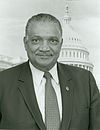 Charles A. Hayes (Chicago) | Democratic | August 23, 1983 – January 3, 1993 | 98th 99th 100th 101st 102nd | Elected to finish Washington's term Re-elected in 1984. Re-elected in 1986. Re-elected in 1988. Re-elected in 1990. Lost renomination. | |
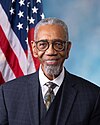 Bobby Rush (Chicago) | Democratic | January 3, 1993 – January 3, 2023 | 103rd 104th 105th 106th 107th 108th 109th 110th 111th 112th 113th 114th 115th 116th 117th | Elected in 1992. Re-elected in 1994. Re-elected in 1996. Re-elected in 1998. Re-elected in 2000. Re-elected in 2002. Re-elected in 2004. Re-elected in 2006. Re-elected in 2008. Re-elected in 2010. Re-elected in 2012. Re-elected in 2014. Re-elected in 2016. Re-elected in 2018. Re-elected in 2020. Retired. | 1993–2003 Expanded into the suburbs for the first time in 90 years, increasing its total area from 32 to 56 square miles (150 km2). It now included: the Chicago communities of Douglas, Oakland, Kenwood, Hyde Park, Woodlawn, Greater Grand Crossing, Avalon Park, Burnside, Chatham and Mount Greenwood; those portions of Auburn Gresham and Washington Heights east of Halsted, those portions of Roseland and Pullman north of 103rd Street, and those portions of Calumet Heights and South Chicago west of Yates Boulevard; the portion of South Deering northwest of 103rd and Yates; South Shore, excepting the area southeast of 71st and Yates; Washington Park, excepting the area northwest of 57th and King Drive; the part of Grand Boulevard north of 43rd Street, as well as most of the area east of Vincennes Avenue; the portion of Armour Square southeast of 35th Street and Princeton Avenue; most of Englewood north of 63rd or east of Halsted; the portion of West Englewood north of 63rd; most of New City southwest of 49th and May Streets; most of Brighton Park southeast of 40th and Kedzie Avenue; portions of Gage Park east of Kedzie, most of Chicago Lawn east of Kedzie, and the portion of Ashburn east of Kedzie; Beverly, excepting the area southeast of 103rd and Prospect Avenue; and most of Morgan Park west of Vincennes. In the suburbs, the district included the villages of Evergreen Park and Merrionette Park, the portion of Alsip east of Cicero Avenue, the portion of Blue Island in Worth Township north of the Calumet Sag Channel, and, with minor variations, the portion of Oak Lawn southeast of 101st and Cicero.[53] |
2003–2013 | |||||
2013–2023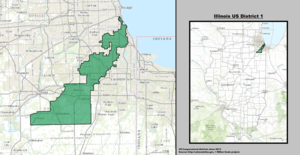 | |||||
 Jonathan Jackson (Chicago) | Democratic | January 3, 2023 – present | 118th | Elected in 2022. | 2023–present |
Election results edit
1832–1840 edit
| Party | Candidate | Votes | % | |
|---|---|---|---|---|
| Democratic | Charles Slade | 2,470 | 31.28 | |
| Democratic-Republican | Ninian Edwards | 2,078 | 26.31 | |
| Democratic | Sidney Breese | 1,770 | 22.41 | |
| Total votes | 7,897 | 100.0 | ||
| Party | Candidate | Votes | % | |
|---|---|---|---|---|
| Democratic | John Reynolds | 4,136 | 41.98 | |
| Democratic | Adam W. Snyder | 3,723 | 37.79 | |
| Unknown | Edward Humphreys | 1,990 | 20.20 | |
| Write-in | 3 | 0.03 | ||
| Total votes | 9,852 | 100.0 | ||
| Party | Candidate | Votes | % | |
|---|---|---|---|---|
| Democratic | John Reynolds | 1,721 | 47.99 | |
| Democratic-Republican | Pierre Menard | 871 | 24.29 | |
| Unknown | William Orr | 501 | 13.97 | |
| Unknown | Henry L. Webb | 490 | 13.66 | |
| Write-in | 3 | 0.08 | ||
| Total votes | 3,586 | 100.0 | ||
| Party | Candidate | Votes | % | |
|---|---|---|---|---|
| Democratic | Adam W. Snyder | 4,552 | 40.06 | |
| Democratic | John Reynolds (incumbent) | 4,441 | 39.08 | |
| Whig | William J. Gatewood | 2,370 | 20.86 | |
| Total votes | 11,363 | 100.0 | ||
| Party | Candidate | Votes | % | ±% | |
|---|---|---|---|---|---|
| Democratic | John Reynolds | 8,032 | 61.16 | +22.08% | |
| Whig | John Hogan | 5100 | 38.84 | +17.98% | |
| Total votes | 13,132 | 100.0 | |||
1841–1850 edit
| Party | Candidate | Votes | % | ±% | |
|---|---|---|---|---|---|
| Democratic | John Reynolds (incumbent) | 8,046 | 59.44 | -1.72% | |
| Whig | Henry L. Webb | 5,313 | 39.25 | +0.41% | |
| John Tyler Supporter | Stephen R. Rowan | 171 | 1.26 | N/A | |
| Write-in | 14 | 0.10 | N/A | ||
| Total votes | 13,537 | 100.0 | |||
| Party | Candidate | Votes | % | ±% | |
|---|---|---|---|---|---|
| Democratic | Robert Smith | 7,347 | 56.11 | -3.33% | |
| Whig | James L. D. Morrison | 5,568 | 42.53 | +3.28% | |
| Liberty | Robert W. Marshall | 176 | 1.34 | N/A | |
| Write-in | 2 | 0.02 | -0.08% | ||
| Total votes | 13,093 | 100.0 | |||
| Party | Candidate | Votes | % | ±% | |
|---|---|---|---|---|---|
| Democratic | Robert Smith (incumbent) | 7,966 | 64.65 | +8.54% | |
| Democratic | John Reynolds | 4,146 | 33.65 | N/A | |
| Liberty | Robert W. Marshall | 191 | 1.55 | +0.21% | |
| Write-in | 36 | 0.29 | +0.27% | ||
| Total votes | 12,321 | 100.0 | |||
| Party | Candidate | Votes | % | ±% | |
|---|---|---|---|---|---|
| Independent Democrat | Robert Smith (incumbent) | 7,068 | 58.13 | -6.52% | |
| Democratic | Lyman Trumbull | 5,019 | 41.28 | N/A | |
| Liberty | B. Marshall | 62 | 0.51 | -1.04% | |
| Write-in | 10 | 0.08 | -0.21% | ||
| Total votes | 12,159 | 100.0 | |||
| Party | Candidate | Votes | % | ±% | |
|---|---|---|---|---|---|
| Democratic | William H. Bissell | 9,892 | 97.74 | +56.46% | |
| Liberty | Charles W. Hunter | 229 | 2.26 | +1.75% | |
| Total votes | 10,121 | 100.0 | |||
| Party | Candidate | Votes | % | ±% | |
|---|---|---|---|---|---|
| Democratic | William H. Bissell (incumbent) | 12,841 | 99.99 | +2.25% | |
| Write-in | 1 | 0.01 | N/A | ||
| Total votes | 100.0 | ||||
1852–1860 edit
| Party | Candidate | Votes | % | ±% | |
|---|---|---|---|---|---|
| Whig | Elihu B. Washburne | 7,392 | 43.93 | N/A | |
| Democratic | Thompson Campbell | 7,106 | 42.23 | -57.76% | |
| Free Soil | Newman Campbell | 2,245 | 13.34 | N/A | |
| Write-in | 85 | 0.51 | +0.50% | ||
| Total votes | 16,828 | 100.0 | |||
| Party | Candidate | Votes | % | ±% | |
|---|---|---|---|---|---|
| Republican | Elihu B. Washburne (incumbent) | 8,372 | 69.33 | +25.40% | |
| Democratic | William M. Jackson | 2,776 | 22.99 | -19.24% | |
| Anti-Nebraska | E. P. Ferry | 927 | 7.68 | N/A | |
| Total votes | 12,075 | 100.0 | |||
| Party | Candidate | Votes | % | ±% | |
|---|---|---|---|---|---|
| Republican | Elihu B. Washburne (incumbent) | 18,070 | 72.61 | +3.28% | |
| Democratic | Richard S. Molony | 6,227 | 25.02 | +2.03% | |
| Unknown | Elisha B. Washburne | 331 | 1.33 | N/A | |
| Know Nothing | B. D. Eastman | 257 | 1.03 | N/A | |
| Total votes | 24,885 | 100.0 | |||
| Party | Candidate | Votes | % | ±% | |
|---|---|---|---|---|---|
| Republican | Elihu B. Washburne (incumbent) | 15,811 | 69.84 | -2.77% | |
| Democratic | Hiram Bright | 6,457 | 28.52 | +3.50% | |
| Democratic Party (Anti-Lecompton) | Richard H. Jackson | 370 | 1.63 | N/A | |
| Total votes | 22,638 | 100.0 | |||
| Party | Candidate | Votes | % | ±% | |
|---|---|---|---|---|---|
| Republican | Elihu B. Washburne (incumbent) | 21,436 | 70.56 | +0.72% | |
| Democratic | Theodore A. C. Beard | 8,929 | 29.39 | +0.87% | |
| Write-in | 14 | 0.05 | N/A | ||
| Total votes | 30,379 | 100.0 | |||
1862–1870 edit
| Party | Candidate | Votes | % | ±% | |
|---|---|---|---|---|---|
| Republican | Isaac N. Arnold | 10,025 | 54.45 | -16.11% | |
| Democratic | Francis Cornwall Sherman | 8,387 | 45.55 | +16.16% | |
| Total votes | 18,412 | 100.0 | |||
| Party | Candidate | Votes | % | ±% | |
|---|---|---|---|---|---|
| National Union | John Wentworth | 18,557 | 56.52 | +2.07% | |
| Democratic | Cyrus McCormick | 14,277 | 43.48 | -2.07% | |
| Total votes | 32,834 | 100.0 | |||
| Party | Candidate | Votes | % | ±% | |
|---|---|---|---|---|---|
| Republican | Norman B. Judd | 15,247 | 72.90 | +16.38% | |
| Democratic | Martin R. M. Wallace | 5,667 | 27.10 | -16.38% | |
| Total votes | 41,828 | 100.0 | |||
| Party | Candidate | Votes | % | ±% | |
|---|---|---|---|---|---|
| Republican | Norman B. Judd (incumbent) | 27,414 | 58.77 | -14.13% | |
| Democratic | Martin R. M. Wallace | 19,233 | 41.23 | +14.13% | |
| Total votes | 46,647 | 100.0 | |||
| Party | Candidate | Votes | % | ±% | |
|---|---|---|---|---|---|
| Republican | Charles B. Farwell | 40,684 | 57.52 | -1.25% | |
| Democratic | John Wentworth | 15,025 | 42.48 | +1.25% | |
| Total votes | 70,734 | 100.0 | |||
1872–1880 edit
| Party | Candidate | Votes | % | ±% | |
|---|---|---|---|---|---|
| Republican | John Blake Rice | 12,870 | 64.01 | +6.49% | |
| Liberal Republican | Lucien B. Otis | 7,235 | 35.99 | N/A | |
| Total votes | 20,105 | 100.0 | |||
| Party | Candidate | Votes | % | ±% | |
|---|---|---|---|---|---|
| Democratic | Bernard G. Caulfield | 10,211 | 51.02 | N/A | |
| Republican | Sidney Smith | 9,803 | 48.98 | -15.03% | |
| Total votes | 20,014 | 100.0 | |||
| Party | Candidate | Votes | % | ±% | |
|---|---|---|---|---|---|
| Democratic | Bernard G. Caulfield | 3,461 | 81.96 | +30.94% | |
| Unknown | H. Eddy | 454 | 10.75 | N/A | |
| Unknown | Henry Vallettee | 308 | 7.29 | N/A | |
| Total votes | 4,223 | 100.0 | |||
| Party | Candidate | Votes | % | ±% | |
|---|---|---|---|---|---|
| Republican | William Aldrich | 16,587 | 53.21 | N/A | |
| Democratic | John Randolph Hoxie | 14,101 | 45.23 | -36.73% | |
| Greenback | George S. Bowen | 486 | 1.56 | N/A | |
| Total votes | 31,174 | 100.0 | |||
| Party | Candidate | Votes | % | ±% | |
|---|---|---|---|---|---|
| Republican | William Aldrich (incumbent) | 12,165 | 51.84 | -1.37% | |
| Democratic | James Rood Doolittle | 7,136 | 30.41 | -14.82% | |
| Socialist Labor | John McAuliff | 2,322 | 9.90 | N/A | |
| Greenback | William V. Barr | 1,844 | 7.86 | +6.30% | |
| Total votes | 23,467 | 100.0 | |||
| Party | Candidate | Votes | % | ±% | |
|---|---|---|---|---|---|
| Republican | William Aldrich (incumbent) | 22,307 | 53.79 | +1.95% | |
| Democratic | John Mattocks | 18,024 | 43.47 | +13.06% | |
| Socialist Labor | J. J. Altpeter | 605 | 1.46 | -8.44% | |
| Greenback | Richard Powers | 532 | 1.28 | -6.58% | |
| Total votes | 41,468 | 100.0 | |||
1882–1890 edit
| Party | Candidate | Votes | % | ±% | |
|---|---|---|---|---|---|
| Republican | Ransom W. Dunham | 11,571 | 50.86 | -2.93% | |
| Democratic | John W. Downes | 10,534 | 46.31 | +2.84% | |
| Greenback | Alonzo J. Glover | 644 | 2.83 | +1.55% | |
| Total votes | 22,749 | 100.0 | |||
| Party | Candidate | Votes | % | ±% | |
|---|---|---|---|---|---|
| Republican | Ransom W. Dunham (incumbent) | 20,245 | 56.73 | +5.87% | |
| Democratic | William M. Tilden | 14,655 | 41.06 | -5.25% | |
| Greenback | Jno. B. Clark | 501 | 1.40 | -1.43% | |
| Unknown | William B. Clark | 288 | 0.81 | N/A | |
| Total votes | 35,689 | 100.0 | |||
| Party | Candidate | Votes | % | ±% | |
|---|---|---|---|---|---|
| Republican | Ransom W. Dunham (incumbent) | 12,321 | 46.89 | -9.84% | |
| Democratic | Edgar Terhune | 7,258 | 27.62 | -13.44% | |
| Labor | Harvey Sheldon, Jr. | 6,358 | 24.20 | N/A | |
| Prohibition | George C. Christian | 337 | 1.28 | N/A | |
| Total votes | 26,274 | 100.0 | |||
| Party | Candidate | Votes | % | ±% | |
|---|---|---|---|---|---|
| Republican | Abner Taylor | 26,553 | 52.86 | +5.97% | |
| Democratic | James F. Todd | 22,697 | 45.19 | +17.57% | |
| Prohibition | Harry S. Taylor | 981 | 1.95 | +0.67% | |
| Total votes | 50,231 | 100.0 | |||
| Party | Candidate | Votes | % | ±% | |
|---|---|---|---|---|---|
| Republican | Abner Taylor (incumbent) | 22,235 | 49.95 | -2.91% | |
| Democratic | William G. Ewing | 21,796 | 48.96 | +3.77% | |
| Prohibition | Isaac H. Pedrick | 483 | 1.09 | -0.86% | |
| Total votes | 44,514 | 100.0 | |||
1892–1900 edit
| Party | Candidate | Votes | % | ±% | |
|---|---|---|---|---|---|
| Republican | J. Frank Aldrich | 39,726 | 49.68 | -0.27% | |
| Democratic | Edwin B. Smith | 37,904 | 47.40 | -1.56% | |
| Prohibition | Winfield S. McComas | 1,738 | 2.17 | +1.08% | |
| Populist | Alfred Clark | 566 | 0.71 | N/A | |
| Labor | P. J. Weldon | 32 | 0.04 | N/A | |
| Total votes | 79,966 | 100.0 | |||
| Party | Candidate | Votes | % | ±% | |
|---|---|---|---|---|---|
| Republican | J. Frank Aldrich (incumbent) | 33,902 | 63.15 | +13.47% | |
| Democratic | Max Dembufsky | 12,854 | 23.94 | -23.46% | |
| Populist | Howard S. Taylor | 5,996 | 11.17 | +10.46% | |
| Prohibition | William H. Craig | 667 | 1.24 | -0.93% | |
| Independent American Citizen | Winfield S. McComas | 269 | 0.50 | N/A | |
| Total votes | 53,688 | 100.0 | |||
| Party | Candidate | Votes | % | ±% | |
|---|---|---|---|---|---|
| Republican | James Robert Mann | 51,582 | 67.64 | +4.49% | |
| Democratic | James H. Teller | 23,123 | 30.32 | +6.38% | |
| Populist | Benjamin J. Werthermer | 957 | 1.25 | -9.92% | |
| Unknown | Thomas R. Strobridge | 595 | 0.78 | N/A | |
| Total votes | 76,257 | 100.0 | |||
| Party | Candidate | Votes | % | ±% | |
|---|---|---|---|---|---|
| Republican | James Robert Mann (incumbent) | 37,500 | 63.23 | -4.41% | |
| Democratic | Rollin B. Organ | 20,424 | 34.43 | +4.11% | |
| Socialist Labor | Bernard Berlyn | 568 | 0.96 | N/A | |
| Prohibition | Theodore L. Neff | 414 | 0.70 | N/A | |
| Populist | James Hogan | 404 | 0.68 | -0.57% | |
| Total votes | 59,310 | 100.0 | |||
| Party | Candidate | Votes | % | ±% | |
|---|---|---|---|---|---|
| Republican | James Robert Mann (incumbent) | 52,775 | 63.02 | -0.21% | |
| Democratic | Leon Hornstein | 28,858 | 34.46 | +0.03% | |
| Social Democratic | William H. Collins | 1,208 | 1.44 | N/A | |
| Prohibition | William P. Ferguson | 899 | 1.07 | +0.37% | |
| Total votes | 83,740 | 100.0 | |||
1902–1910 edit
| Party | Candidate | Votes | % | ±% | |
|---|---|---|---|---|---|
| Democratic | Martin Emerich | 16,591 | 51.29 | +16.83% | |
| Republican | Martin B. Madden | 15,339 | 47.42 | -15.60% | |
| Prohibition | Howard T. Wilcoxon | 415 | 1.28 | +0.21% | |
| Total votes | 32,345 | 100.0 | |||
| Party | Candidate | Votes | % | ±% | |
|---|---|---|---|---|---|
| Republican | Martin B. Madden | 24,097 | 58.00 | +10.58% | |
| Democratic | John S. Oehman | 9,166 | 22.06 | -29.23% | |
| Independent Republican | David S. Geer | 5,175 | 12.46 | N/A | |
| Socialist | Edward Loewenthal | 2,334 | 5.62 | N/A | |
| Prohibition | William H. Craig | 416 | 1.00 | -0.28% | |
| Populist | Charles Roberts | 234 | 0.56 | N/A | |
| Continental Party | J. P. Lynch | 127 | 0.31 | N/A | |
| Total votes | 41,549 | 100.0 | |||
| Party | Candidate | Votes | % | ±% | |
|---|---|---|---|---|---|
| Republican | Martin B. Madden (incumbent) | 17,015 | 59.32 | +1.32% | |
| Democratic | Martin Emerich | 10,015 | 34.92 | +12.86% | |
| Socialist | J. H. Greer | 1,402 | 4.89 | -0.73% | |
| Prohibition | Amasa Orelup | 251 | 0.88 | -0.12% | |
| Total votes | 28,683 | 100.0 | |||
| Party | Candidate | Votes | % | ±% | |
|---|---|---|---|---|---|
| Republican | Martin B. Madden (incumbent) | 23,370 | 60.92 | +1.60% | |
| Democratic | Matthew L. Mandable | 13,692 | 35.69 | +0.77% | |
| Socialist | Joseph N. Greer | 825 | 2.15 | -2.74% | |
| Independent | Henry W. Young | 469 | 1.22 | N/A | |
| Independent | Charles McCormick | 7 | 0.02 | N/A | |
| Total votes | 38,363 | 100.0 | |||
| Party | Candidate | Votes | % | ±% | |
|---|---|---|---|---|---|
| Republican | Martin B. Madden (incumbent) | 14,920 | 49.99 | -10.93% | |
| Democratic | Michael E. Maher | 13,466 | 45.12 | +9.43% | |
| Socialist | Joseph H. Greer | 1,165 | 3.90 | +1.75% | |
| Prohibition | H. E. Eckles | 293 | 0.98 | N/A | |
| Total votes | 29,844 | 100.0 | |||
1912–1920 edit
| Party | Candidate | Votes | % | ±% | |
|---|---|---|---|---|---|
| Republican | Martin B. Madden (incumbent) | 13,608 | 52.16 | +2.17% | |
| Democratic | Andrew Donovan | 9,967 | 38.20 | -6.92% | |
| Socialist | William F. Barnard | 2,217 | 8.50 | +4.60% | |
| Prohibition | W. H. Rogers | 299 | 1.15 | +0.17% | |
| Total votes | 26,091 | 100.0 | |||
| Party | Candidate | Votes | % | ±% | |
|---|---|---|---|---|---|
| Republican | Martin B. Madden (incumbent) | 13,063 | 53.22 | +1.06% | |
| Democratic | James M. Quinlan | 9,060 | 36.91 | -1.29% | |
| Progressive | Henry M. Ashton | 1,758 | 7.16 | N/A | |
| Socialist | Charles Leffler | 662 | 2.70 | -5.80% | |
| Total votes | 24,543 | 100.0 | |||
| Party | Candidate | Votes | % | ±% | |
|---|---|---|---|---|---|
| Republican | Martin B. Madden (incumbent) | 20,380 | 59.06 | +5.84% | |
| Democratic | William J. Hennessey | 13,380 | 38.77 | +1.86% | |
| Socialist | Robert H. Howe | 749 | 2.17 | -0.53% | |
| Total votes | 34,509 | 100.0 | |||
| Party | Candidate | Votes | % | ±% | |
|---|---|---|---|---|---|
| Republican | Martin B. Madden (incumbent) | 12,580 | 55.33 | -3.73% | |
| Democratic | George Mayer | 9,776 | 43.00 | +4.23% | |
| Socialist | G. J. Carlisle | 381 | 1.68 | -0.49% | |
| Total votes | 22,737 | 100.0 | |||
| Party | Candidate | Votes | % | ±% | |
|---|---|---|---|---|---|
| Republican | Martin B. Madden (incumbent) | 41,907 | 75.91 | +20.58% | |
| Democratic | James A. Gorman | 12,398 | 22.46 | -20.54% | |
| Socialist | Willis E. Davis | 899 | 1.63 | -0.05% | |
| Total votes | 55,204 | 100.0 | |||
1922–1930 edit
| Party | Candidate | Votes | % | ±% | |
|---|---|---|---|---|---|
| Republican | Martin B. Madden (incumbent) | 23,895 | 59.09 | -16.82% | |
| Democratic | George Mayer | 15,999 | 39.56 | +17.10% | |
| Socialist | Charles Hallbeck | 427 | 1.06 | -0.57% | |
| Farmer–Labor | John H. Kennedy | 120 | 0.30 | N/A | |
| Total votes | 40,441 | 100.0 | |||
| Party | Candidate | Votes | % | ±% | |
|---|---|---|---|---|---|
| Republican | Martin B. Madden (incumbent) | 43,661 | 73.05 | +13.96% | |
| Democratic | James F. Doyle | 13,623 | 22.79 | -16.77% | |
| Independent | Samuel A. T. Watkins | 2,232 | 3.73 | N/A | |
| Socialist | Elmer Whitmore | 220 | 0.37 | -0.69% | |
| Independent | Gordon Owens | 32 | 0.05 | N/A | |
| Total votes | 59,768 | 100.0 | |||
| Party | Candidate | Votes | % | ±% | |
|---|---|---|---|---|---|
| Republican | Martin B. Madden (incumbent) | 26,559 | 68.20 | -4.85% | |
| Democratic | James F. Doyle | 12,283 | 31.54 | +8.75% | |
| Progressive | G. Victor Cools | 101 | 0.26 | N/A | |
| Total votes | 38,943 | 100.0 | |||
| Party | Candidate | Votes | % | ±% | |
|---|---|---|---|---|---|
| Republican | Oscar DePriest | 24,479 | 47.79 | -20.41% | |
| Democratic | Harry Baker | 20,664 | 40.34 | +8.80% | |
| Independent | William Harrison | 5,861 | 11.44 | N/A | |
| Independent | Benjamin W. Clayton | 123 | 0.24 | N/A | |
| Independent | Edward L. Doty | 100 | 0.20 | N/A | |
| Total votes | 51,227 | 100.0 | |||
| Party | Candidate | Votes | % | ±% | |
|---|---|---|---|---|---|
| Republican | Oscar DePriest (incumbent) | 23,719 | 58.36 | +10.57% | |
| Democratic | Harry Baker | 16,747 | 41.21 | +0.87% | |
| Independent | George W. Harts | 68 | 0.17 | N/A | |
| Independent | T. W. Chavers | 64 | 0.16 | N/A | |
| Independent | Edward Turner | 44 | 0.11 | N/A | |
| Total votes | 40,642 | 100.0 | |||
1932–1940 edit
| Party | Candidate | Votes | % | ±% | |
|---|---|---|---|---|---|
| Republican | Oscar DePriest (incumbent) | 33,672 | 54.77 | -3.59% | |
| Democratic | Harry Baker | 26,959 | 43.85 | +2.64% | |
| Independent | Herbert Newton | 843 | 1.37 | N/A | |
| Total votes | 61,474 | 100.0 | |||
| Party | Candidate | Votes | % | ±% | |
|---|---|---|---|---|---|
| Democratic | Arthur W. Mitchell | 27,963 | 52.97 | +9.12% | |
| Republican | Oscar DePriest (incumbent) | 24,829 | 47.03 | -7.74% | |
| Total votes | 52,792 | 100.0 | |||
| Party | Candidate | Votes | % | ±% | |
|---|---|---|---|---|---|
| Democratic | Arthur W. Mitchell (incumbent) | 35,376 | 55.10 | +2.13% | |
| Republican | Oscar DePriest | 28,640 | 44.61 | -2.42% | |
| Independent | Harry Haywood | 192 | 0.30 | N/A | |
| Total votes | 64,208 | 100.0 | |||
| Party | Candidate | Votes | % | ±% | |
|---|---|---|---|---|---|
| Democratic | Arthur W. Mitchell (incumbent) | 30,207 | 53.37 | -1.73% | |
| Republican | William L. Dawson | 26,396 | 46.63 | +2.02% | |
| Total votes | 56,603 | 100.0 | |||
| Party | Candidate | Votes | % | ±% | |
|---|---|---|---|---|---|
| Democratic | Arthur W. Mitchell (incumbent) | 34,641 | 53.02 | -0.35% | |
| Republican | William E. King | 30,698 | 46.98 | +0.35% | |
| Total votes | 65,339 | 100.0 | |||
1942–1950 edit
| Party | Candidate | Votes | % | ±% | |
|---|---|---|---|---|---|
| Democratic | William L. Dawson | 26,280 | 52.75 | -0.27% | |
| Republican | William E. King | 23,537 | 47.25 | +0.27% | |
| Total votes | 49,817 | 100.0 | |||
| Party | Candidate | Votes | % | ±% | |
|---|---|---|---|---|---|
| Democratic | William L. Dawson (incumbent) | 42,713 | 61.98 | +9.23% | |
| Republican | William E. King | 26,204 | 38.02 | -9.23% | |
| Total votes | 68,917 | 100.0 | |||
| Party | Candidate | Votes | % | ±% | |
|---|---|---|---|---|---|
| Democratic | William L. Dawson (incumbent) | 38,040 | 56.79 | -5.19% | |
| Republican | William E. King | 28,945 | 43.21 | +5.19% | |
| Total votes | 66,985 | 100.0 | |||
| Party | Candidate | Votes | % | ±% | |
|---|---|---|---|---|---|
| Democratic | William L. Dawson (incumbent) | 98,690 | 66.96 | +10.17% | |
| Republican | William E. King | 43,034 | 29.20 | -14.01% | |
| Progressive | Earl B. Dickerson | 5,669 | 3.85 | N/A | |
| Total votes | 147,393 | 100.0 | |||
| Party | Candidate | Votes | % | ±% | |
|---|---|---|---|---|---|
| Democratic | William L. Dawson (incumbent) | 69,506 | 61.74 | -5.22% | |
| Republican | Archibald James Carey, Jr. | 41,944 | 37.26 | +8.06% | |
| Progressive | Samuel J. Parks | 1,135 | 1.01 | -2.84% | |
| Total votes | 112,585 | 100.0 | |||
1952–1960 edit
| Party | Candidate | Votes | % | ±% | |
|---|---|---|---|---|---|
| Democratic | William L. Dawson (incumbent) | 95,899 | 73.50 | +11.76% | |
| Republican | Edgar G. Brown | 34,571 | 26.50 | -10.76% | |
| Total votes | 130,470 | 100.0 | |||
| Party | Candidate | Votes | % | ±% | |
|---|---|---|---|---|---|
| Democratic | William L. Dawson (incumbent) | 71,472 | 75.28 | +1.78% | |
| Republican | Genoa S. Washington | 23,470 | 24.72 | -1.78% | |
| Total votes | 94,942 | 100.0 | |||
| Party | Candidate | Votes | % | ±% | |
|---|---|---|---|---|---|
| Democratic | William L. Dawson (incumbent) | 66,704 | 64.42 | -10.86% | |
| Republican | George W. Lawrence | 36,847 | 35.58 | +10.86% | |
| Total votes | 103,551 | 100.0 | |||
| Party | Candidate | Votes | % | ±% | |
|---|---|---|---|---|---|
| Democratic | William L. Dawson (incumbent) | 60,778 | 72.22 | +7.80% | |
| Republican | Dr. Theodore R. M. Howard | 23,384 | 27.78 | -7.80% | |
| Total votes | 84,162 | 100.0 | |||
| Party | Candidate | Votes | % | ±% | |
|---|---|---|---|---|---|
| Democratic | William L. Dawson (incumbent) | 75,938 | 77.81 | +5.59% | |
| Republican | Genoa S. Washington | 21,660 | 22.19 | -5.59% | |
| Total votes | 97,598 | 100.0 | |||
1962–1970 edit
| Party | Candidate | Votes | % | ±% | |
|---|---|---|---|---|---|
| Democratic | William L. Dawson (incumbent) | 98,305 | 74.09 | -3.72% | |
| Republican | Benjamin C. Duster | 34,379 | 25.91 | +3.72% | |
| Total votes | 132,684 | 100.0 | |||
| Party | Candidate | Votes | % | ±% | |
|---|---|---|---|---|---|
| Democratic | William L. Dawson (incumbent) | 150,953 | 84.91 | +10.82% | |
| Republican | Wilbur N. Daniel | 26,823 | 15.09 | -10.82% | |
| Total votes | 177,776 | 100.0 | |||
| Party | Candidate | Votes | % | ±% | |
|---|---|---|---|---|---|
| Democratic | William L. Dawson (incumbent) | 91,119 | 72.58 | -12.33% | |
| Republican | David R. Reed | 34,421 | 27.42 | +12.33% | |
| Total votes | 125,540 | 100.0 | |||
| Party | Candidate | Votes | % | ±% | |
|---|---|---|---|---|---|
| Democratic | William L. Dawson (incumbent) | 119,207 | 84.56 | +11.98% | |
| Republican | Janet Roberts Jennings | 21,758 | 15.44 | -11.98% | |
| Total votes | 140,965 | 100.0 | |||
| Party | Candidate | Votes | % | ±% | |
|---|---|---|---|---|---|
| Democratic | Ralph H. Metcalfe | 93,272 | 90.96 | +6.40% | |
| Republican | Janet Roberts Jennings | 9,267 | 9.04 | -6.40% | |
| Total votes | 102,539 | 100.0 | |||
1972–1980 edit
| Party | Candidate | Votes | % | ±% | |
|---|---|---|---|---|---|
| Democratic | Ralph H. Metcalfe (incumbent) | 136,755 | 91.39 | +0.43% | |
| Republican | Louis H. Coggs | 12,877 | 8.61 | -0.43% | |
| Write-in | 2 | 0.00 | N/A | ||
| Total votes | 149,634 | 100.0 | |||
| Party | Candidate | Votes | % | ±% | |
|---|---|---|---|---|---|
| Democratic | Ralph H. Metcalfe (incumbent) | 75,206 | 93.74 | +2.35% | |
| Republican | Oscar H. Haynes | 4,399 | 5.48 | -3.13% | |
| Socialist Workers | Willie Mae Reid | 620 | 0.77 | N/A | |
| Total votes | 80,225 | 100.0 | |||
2002 edit
| Party | Candidate | Votes | % | |
|---|---|---|---|---|
| Democratic | Bobby Rush* | 149,068 | 81.17 | |
| Republican | Raymond G. Wardingley | 29,776 | 16.21 | |
| Libertarian | Dorothy Tsatsos | 4,812 | 2.62 | |
| Total votes | 183,656 | 100.00 | ||
| Turnout | ||||
| Democratic hold | ||||
2004 edit
| Party | Candidate | Votes | % | |
|---|---|---|---|---|
| Democratic | Bobby Rush* | 211,115 | 84.82 | |
| Republican | Raymond G. Wardingley | 37,793 | 15.18 | |
| Total votes | 248,908 | 100.00 | ||
| Turnout | ||||
| Democratic hold | ||||
2006 edit
| Party | Candidate | Votes | % | |
|---|---|---|---|---|
| Democratic | Bobby Rush* | 146,623 | 84.06 | |
| Republican | Jason E. Tabour | 27,804 | 15.94 | |
| Total votes | 174,427 | 100.00 | ||
| Turnout | ||||
| Democratic hold | ||||
2008 edit
| Party | Candidate | Votes | % | |
|---|---|---|---|---|
| Democratic | Bobby Rush* | 233,036 | 85.87 | |
| Republican | Antoine Members | 38,361 | 14.13 | |
| Total votes | 271,397 | 100.00 | ||
| Turnout | ||||
| Democratic hold | ||||
2010 edit
| Party | Candidate | Votes | % | |
|---|---|---|---|---|
| Democratic | Bobby Rush* | 148,170 | 80.36 | |
| Republican | Raymond G. Wardingley | 29,253 | 15.87 | |
| Green | Jeff Adams | 6,963 | 3.78 | |
| Total votes | 184,386 | 100.00 | ||
| Turnout | ||||
| Democratic hold | ||||
2012 edit
| Party | Candidate | Votes | % | |
|---|---|---|---|---|
| Democratic | Bobby Rush (incumbent) | 236,854 | 73.8 | |
| Republican | Donald Peloquin | 83,989 | 26.2 | |
| Independent | John Hawkins (write-in) | 1 | 0.0 | |
| Total votes | 320,844 | 100.0 | ||
| Democratic hold | ||||
2014 edit
| Party | Candidate | Votes | % | |
|---|---|---|---|---|
| Democratic | Bobby Rush (incumbent) | 162,268 | 73.1 | |
| Republican | Jimmy Lee Tillman | 59,749 | 26.9 | |
| Total votes | 222,017 | 100.0 | ||
| Democratic hold | ||||
2016 edit
| Party | Candidate | Votes | % | |
|---|---|---|---|---|
| Democratic | Bobby Rush (incumbent) | 234,037 | 74.1 | |
| Republican | August Deuser | 81,817 | 25.9 | |
| Independent | Tabitha Carson (write-in) | 8 | 0.0 | |
| Total votes | 315,862 | 100.0 | ||
| Democratic hold | ||||
2018 edit
| Party | Candidate | Votes | % | |
|---|---|---|---|---|
| Democratic | Bobby Rush (incumbent) | 189,560 | 73.5 | |
| Republican | Jimmy Lee Tillman, II | 50,960 | 19.8 | |
| Independent | Thomas Rudbeck | 17,365 | 6.7 | |
| Total votes | 257,885 | 100.0 | ||
| Democratic hold | ||||
2020 edit
| Party | Candidate | Votes | % | ±% | |
|---|---|---|---|---|---|
| Democratic | Bobby Rush (incumbent) | 239,943 | 73.80 | +0.29% | |
| Republican | Philanise White | 85,027 | 26.15 | +6.39% | |
| Write-in | 153 | 0.05 | N/A | ||
| Total votes | 325,123 | 100.0 | |||
| Democratic hold | |||||
2022 edit
| Party | Candidate | Votes | % | |
|---|---|---|---|---|
| Democratic | Jonathan Jackson | 159,142 | 67.03 | |
| Republican | Eric Carlson | 78,258 | 32.96 | |
| Write-in | 25 | 0.01 | ||
| Total votes | 237,425 | 100.0 | ||
| Democratic hold | ||||
See also edit
References edit
External links edit
- Washington Post page on the 1st District of Illinois
- "Statistical Abstract of the United States: 2003" (PDF). (163 KiB) – Congressional District Profiles, U.S. Census Bureau
- "U.S. Census Bureau – 1st District map" (PDF). (1.47 MiB)
- U.S. Census Bureau – 1st District Fact Sheet




